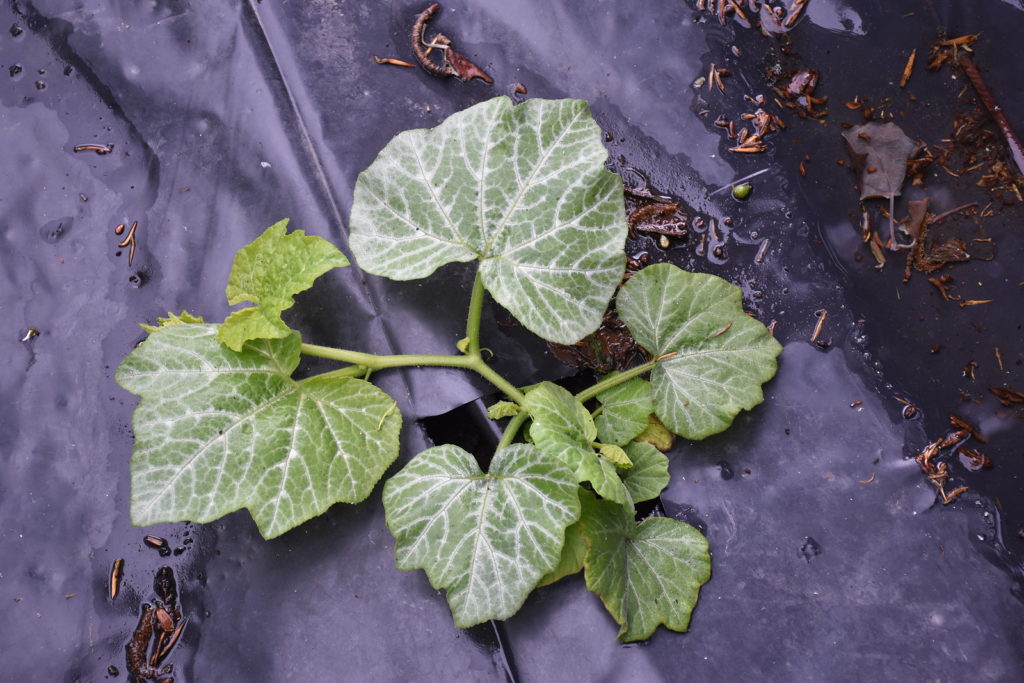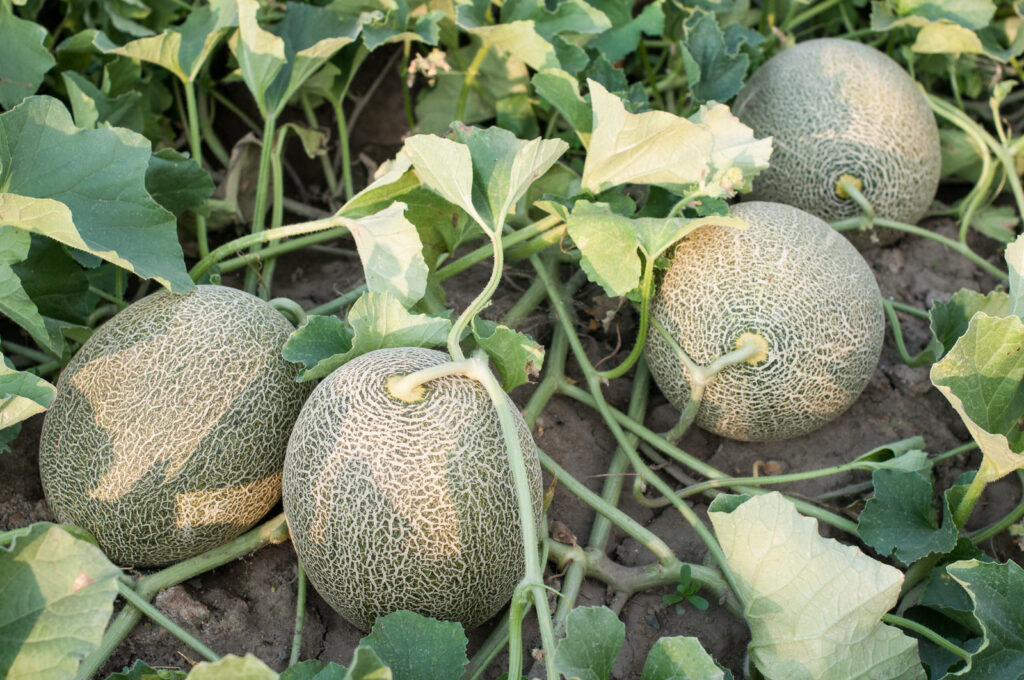Muskmelons, cantaloupes, winter melons, and watermelons: they all thrive under the same cultural conditions and they all share similar growing problems.
- Cantaloupes are muskmelons: these melons have pumpkin-like ribbing, a skin covered with a netting of shallow veins, and most varieties have a musk smell.
- Winter melons (which are a type of muskmelon) ripen at the very end of summer as the weather turns cool: honeydews, Crenshaw, Casaba, and Persians.
- Watermelons–which are a different botanical family than muskmelons and winter melons–share all of the growing requirements.

Melon problems and solutions
Leaf problems
Leaves curl under and become deformed and yellowish.
Aphids are tiny, oval, and yellowish to greenish pear-shaped insects that colonize the undersides of leaves. They leave behind sticky excrement called honeydew which can turn into a black sooty mold. Use insecticidal soap.
Leaves turn pale green, yellow, or brown; dusty silver webs on the undersides of leaves and between vines.
Spider mites suck plant juices causing stippling. Spray with water or use insecticidal soap or rotenone. Ladybugs and lacewings eat mites.
Leaves yellow; tiny white-winged insects around plants.
Whiteflies will congregate on the undersides of leaves and fly up when disturbed. Remove infested leaves and the whole plant if infestation is serious. Introduce beneficial insects into the garden.
Coarse white speckling or stippling on the upper surface of leaves; leaves may turn brown.
Leafhoppers are green, brown, or yellow bugs with wedge-shaped wings. They suck the juices from leaves and stems. Use floating row covers to exclude bugs; spray with insecticidal soap.
Trails and tunnels in leaves.
The leafminer larvae tunnel inside leaves. Destroy infected leaves and cultivate the garden to destroy larvae and keep adult flies from laying eggs. Cover crops with floating row covers.
Water-soaked blotches on leaves–not enlarging past leaf veins; water-soaked spots can appear on fruits
Angular leaf spot or bacterial spot is a waterborne bacterium that causes irregular geometric patterns on leaves. Spots may turn yellow and crisp. Avoid wetting foliage with irrigation. Prune off infected leaves and stems. Clean up garden. Plant disease-resistant varieties. Rotate crops for up to 2 years.
Holes chewed in leaves, leaves skeletonized; runners, and young fruit scarred.
Spotted cucumber beetle is greenish, yellowish, ¼ inch (7mm) long with black spots and a black head. Striped cucumber beetle has wide black stripes on the wing covers. Handpick; mulch around plants; plant resistant varieties; dust with wood ashes.
Leaves have yellow specks that turn brown, then black; vines wilt from the point of attack.
Squash bug is a flat, shield-shaped black or brownish bug with a triangle on its back; it sucks juices from plants. Trap adults beneath boards in spring, hand pick and destroy.
Round white powdery spots and coating on leaves.
Powdery mildew is caused by fungal spores. Spores germinate on dry leaf surfaces when the humidity is high; spores do not germinate on wet leaves. Common in late summer or fall but does not result in the loss of the plant. Avoid water stress. Pick off infected leaves.
Irregular yellowish to brownish spots on upper leaf surfaces; grayish powder or mold on undersides.
Downy mildew is caused by a fungus. Improve air circulation. Plant disease-resistant varieties. Rotate crops. Keep the garden free of plant debris.
Mottled, distorted leaves.
Mosaic virus causes leaves to become thickened, brittle, and easily broken from the plant; plants are stunted and yields are poor. The virus is spread from plant to plant by aphids and leafhoppers. Remove diseased plants. Remove broadleaf weeds that serve as virus reservoir.

Whole plant problems
Plants wilt and die beginning with crown or older topmost leaves.
Verticillium wilt is a soilborne fungus. Light brown streaks can be seen in the stem split lengthwise. Rotate crops. Avoid soil previously planted in cucumbers and family members, potatoes, peppers, eggplant, and tomatoes.
Vines wilt suddenly and die starting with one or two leaves.
Bacterial wilt clogs the circulatory system of plants. It is caused by bacteria that is transmitted by cucumber beetles and is seen often where the soil stays moist. Remove and destroy infected plants before the disease spreads. Control cucumber beetles with rotenone or sabadilla. Wash hands and clean tools with a bleach solution.
Plants are stunted and yellow; runners turn yellow and wilt gradually die.
The entire plant collapses. One-sided brown lesion may form on the affected runner for 1 to 2 feet. Fusarium wilt is a fungal disease that infects plant vascular tissues. Fungal spores live in the soil and can be carried by cucumber beetles. Plant disease-resistant varieties. Rotate crops. Remove and destroy infected plants. Fungicides are not effective.

Flower problems
Early flowers don’t set fruit.
A couple of possible reasons: (1) There may not be enough pollinators, mostly bees. Hand-pollinate using an artist’s paintbrush. Bee activity may be low because of cool weather or insecticides.
Fruit problems
Fruit is misshapen or flavor is bitter.
Several possible reasons: (1) Inadequate pollination: be sure bees and pollinators can get to flowers; (2) dry soil: keep the soil evenly moist while melons are developing; use drip or trickle irrigation in drought and mulch to retain soil moisture; (3) high temperatures: temperature swings of 20° or more can cause bitter flavor; keep soil mulched; (4) poor soil fertility: add aged compost to planting beds and side dress melons with aged compost.
Water-soaked spots–sunken, brown, or black–on fruit.
Belly rot, bacterial spot or blight, blossom end rot. Remove and destroy infected fruits. Remove all plants and plant debris at the end of the season. Promote good drainage by adding organic materials to planting beds. Keep the soil evenly moist; mulch to retain soil moisture. Avoid overhead watering. Rotate crops.
Plants produce few fruits, mostly foliage.
Plants are likely spaced too close together. Space plants at recommended distances, 8 to 12 inches apart. Plants spaced too close or too far apart yield fewer fruits as a result of poor pollination.
Melon growing success tips
Planting time
All melons require a growing season of at least 100 frost-free days. Plant melons when the soil has warmed to 70° to 80°F. To jumpstart the season, start seeds indoors from 2 to 4 weeks before transplanting seedlings to the garden.
Planting
Grow melons in full sun with plenty of air circulation. Melons must stay warm and dry to prevent disease and grow quickly and uninterrupted. Grow melons in loose, well-drained soil rich in organic matter. Prepare planting beds with aged compost and side dress with compost during the growing season. Grow melons on raised hills: 4 to 6 feet apart for muskmelons, 6 to 12 feet apart for watermelons. Thin to 2 to 3 melons per hill or fewer.
Care
Mulch to keep down weeds. Water to keep melons evenly moist; do not let the soil dry after transplanting or as fruits develop. Male flowers will appear first followed by female flowers. Give melons manure tea when the fruit sets and again about two weeks later. Don’t allow new flowers to develop after midsummer; let the plant concentrate it growing efforts on fruit that can mature before the end of warm weather.
Harvest
Muskmelons and cantaloupes that smell ripe are ripe. They will come away clean from the vine with little pressure. Thump watermelons to determine if it is ready for picking: a ripe watermelon will make a dull thump.
More melon-growing tips:
Melon articles at Harvest to Table:
How to Plant and Grow Watermelon
How to Harvest and Store Melons
How to Harvest and Store Watermelon
Melon Growing Problems Troubleshooting
Serve Watermelon With These Flavor Matches
Vegetable Garden Disease Problems Solver
Vegetable Garden Organic Weed Control
Vegetable Garden Organic Pest Control
Garden Planning Books at Amazon:
- Vegetable Garden Almanac & Planner
- Kitchen Garden Grower’s Guide Vegetable Encyclopedia
- Vegetable Garden Grower’s Guide
- Tomato Grower’s Answer Book















